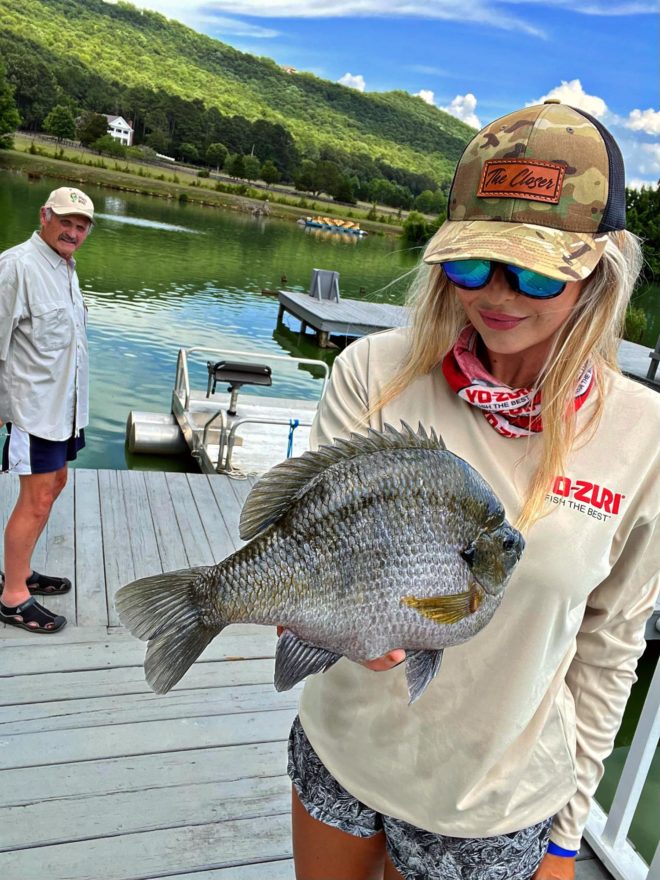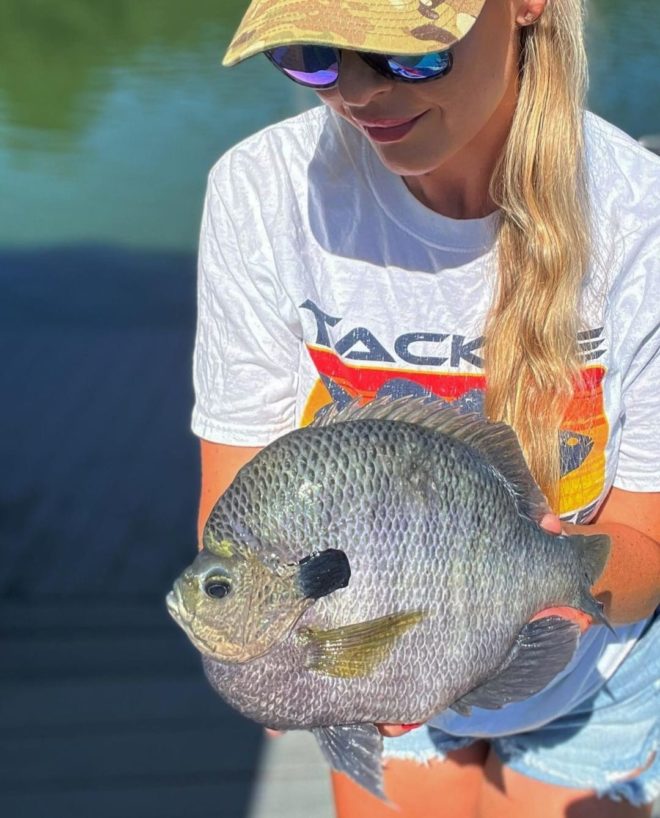Pond management is a ‘delicate dance’

By Greg McCain
The potential to create a thriving fish population in a pond is a labor of love for Sarah Parvin. It also requires time, effort, money, and a level of expertise that most people do not possess.
In Part I of a two-part series, Sarah discussed her dreams of growing the world record bluegill at her Huntsville, AL, five-acre facility called the Slab Lab, built some 27 years ago by her father, Dr. Dennis Olive. Part II focuses on the pond management side of the equation, heavily considering the one factor – water quality – that Sarah deems vitally important in growing trophy fish.

The most important consideration of a healthy pond is “managing your water,” Sarah said. “Your water is the one thing that can make or break attempts at growing trophy fish. The one time that your water gets out of balance, your entire pond is in jeopardy. For most pond owners who operate at the level that we operate, that’s a lot of money. It’s a huge investment (both in terms of money and time). My dad and I are out there multiple times per day seven days a week monitoring the pond.”
First of all, a reliable water source is a necessity. People who invest time, effort, and money into building a pond can not simply rely on nature to supply the needed water in the form of rainfall. Natural springs that run year-round are ideal. A well furnishes much of the water for the Slab Lab, especially in the hotter months.
“The well is under water, and we can turn it off and on,” Sarah said. “We run it 24/7 right now because of the lack of rain and high evaporation rates with the heat we have.”
Once a pond is built and filled with water, just how does one maintain water quality? Sarah offers some suggestions about measuring water quality but repeatedly stresses the need to call in even more qualified experts if necessary.
“So visibility is one way to measure the quality of the water,” she said. “Using a secchi disk is a tool many pond owners use. It’s a disk you lower into the water until you can’t see it anymore. You mark the rope and that tells you the distance of visibility. Most pond management companies follow a rule of thumb of 16-18 inches. That means you have enough healthy bloom in the water to feed small fish.”
The level of dissolved oxygen is another consideration for any pond owner, especially as water temps rise through late spring, through the summer, and into the fall. Extreme heat and droughts conditions, like those currently plaguing many parts of the country, also exacerbate the situation.
Sarah monitors dissolved oxygen levels with a DO meter. She also runs the aeration system of her pond regularly through the hottest summer months. It consists of six underwater aeration devices and two large paddle wheels.
Dredging is another possibility for keeping water in good shape, particularly for an older pond.
“Pulling out older soil and muck will help with water clarity,” Sarah said.
If a pond experiences too much of a good thing – overly fertile water can lead to extensive algae blooms that potentially result in fish kills and dead livestock, pets, and wildlife – extreme measures like adding certain chemicals can reverse the process.
Sarah, however, strongly advises leaving that approach to certified experts. She also said that some of the chemicals can only be obtained and used with a special license or permit. In those situations, “It’s always best to have a pond management company diagnose and treat any issues you face as a pond owner.
Following are other suggestions by Sarah about pond management:
- Another of Sarah’s ideas about pond management involves feeding the fish. Maintaining a healthy population requires just the right balance of quality and quantity of feed. “Know the quality of the feed that you use,” Sarah said. “It does make a difference.” The food that grows giant bluegills at the Slab Lab comes from Optimal Fish Food (www.optimalfishfood.com), which produces various types of food, including a mix called the Signature Series created exclusively for specific ponds. Sarah stressed the “high-protein, low-phosphorus” make-up of the blend she feeds. While Sarah said she “feeds heavy,” she also said it’s important not to overfeed. Leftover food can negatively impact the water quality in a pond.
- Fish need structure to survive. “You have to have the right environment,” Sarah said. That idea applies to just about every species, including bluegills. Sarah said her five-acre pond has a mix of structures that provide cover for fledgling fish. “We have rip rap, tires, old Christmas trees, concrete culverts, lots of rock piles, and berms built up with gravel for spawning,” she said. Pond owners do not necessarily need all the different types but need to build sanctuaries for fry, which are typically easy pickings in open water.
- Genetics is another part of the equation, Sarah said. When the pond was re-stocked about four years ago following a fish kill, she soon recognized the superior grade of bluegill growing in the pond, the largest of which she has documented at 3 ½ lbs. She said the pond is full of fish over two lbs. and probably has a four-pounder in it. “Knowing what you are getting and what you are stocking is paramount to having trophy fish,” Sarah said, “whether it’s bass or bluegill or something else.” Having a trusted source for stocking is important.
- For Sarah, that source is American Sport Fish Hatchery (www.americansportfish.com), a business with operations in both Alabama and Texas. American Sport Fish re-stocked the pond with coppernose bluegills and also Tiger-strain largemouth bass four years ago. Sarah’s partnership with the company involves not only stocking the fish but also consulting about overall management of the pond. “They do a little bit of everything to help us grow giant bluegills,” she said. To sum up the idea, don’t be afraid to hire an outside expert to help manage all pond resources.
Sarah describes the process of maintaining a pond and growing trophy fish as a “delicate dance.” For now, the dance is perfectly choreographed. Her ideas specifically apply to conditions at the Slab Lab, but in a more general sense, can help other property owners build a dream pond of their own.
Follow Sarah on social media at Sarah Parvin (The Closer) on Facebook and @sarah_the_closer_parvin on Instagram. She also produces regular TikTok videos as well.













